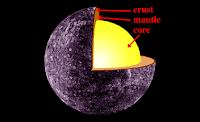"Whoa, back up a bit," you must be saying. "Emission nebula? What's that?"

In side of that picture of Trifid Nebula, there is a lot going on. This picture by the way was taken in the night sky over Abilene, Texas.
But to answer your question, we should look at each individual thing in this picture.
This is the Rosette Nebula in the constellation Monoceros (mo-nos-er-os). The nebula surrounds a young star cluster.
 This nebula is emitting its own light, due to the presence of ultraviolet radiation from the very hot young stars that make up the cluster. This radiation, although not visible to the eye, is strong enough to 'excite' the atoms in the interstellar dust and gas so that they 'jump' to different energy levels and emit their own form of radiation which can be seen in the nebula's light spectrum. It is not simply reflecting the light from the cluster.
This nebula is emitting its own light, due to the presence of ultraviolet radiation from the very hot young stars that make up the cluster. This radiation, although not visible to the eye, is strong enough to 'excite' the atoms in the interstellar dust and gas so that they 'jump' to different energy levels and emit their own form of radiation which can be seen in the nebula's light spectrum. It is not simply reflecting the light from the cluster.But a reflection nebula does.
 Reflection nebulas reflect light from a nearby star. Many small carbon grains in the nebula reflect the light. The blue color typical of reflection nebula is caused by blue light being more efficiently scattered by the carbon dust than red light. The brightness of the nebula is determined by the size and density of the reflecting grains, and by the color and brightness of the neighboring star(s).
Reflection nebulas reflect light from a nearby star. Many small carbon grains in the nebula reflect the light. The blue color typical of reflection nebula is caused by blue light being more efficiently scattered by the carbon dust than red light. The brightness of the nebula is determined by the size and density of the reflecting grains, and by the color and brightness of the neighboring star(s).Dark nebula, also seen in that first picture. This is a good example of a dark nebula, which is one that is blocking the light from whatever is behind it (which could make a shape - in this case, a horsehead).

You will find these in an emission nebula, which as I should have mentioned is a cloud of a high temperature gas. The atoms that are in the cloud get energized by light from a close star. These types of nebulae are usually red because of the amount of hydrogen.













































